
A rose is a woody perennial flowering plant of the genus Rosa, in the family Rosaceae, or the flower it bears. There are over three hundred species and tens of thousands of cultivars. They form a group of plants that can be erect shrubs, climbing, or trailing, with stems that are often armed with sharp prickles. Flowers vary in size and shape and are usually large and showy, in colours ranging from white through yellows and reds. Most species are native to Asia, with smaller numbers native to Europe, North America, and northwestern Africa. Species, cultivars and hybrids are all widely grown for their beauty and often are fragrant. Roses have acquired cultural significance in many societies. Rose plants range in size from compact, miniature roses, to climbers that can reach seven meters in height. Different species hybridize easily, and this has been used in the development of the wide range of garden roses.

Thyme is the herb of some members of the genus Thymus of aromatic perennial evergreen herbs in the mint family Lamiaceae. Thymes are relatives of the oregano genus Origanum. They have culinary, medicinal, and ornamental uses, and the species most commonly cultivated and used for culinary purposes is Thymus vulgaris.
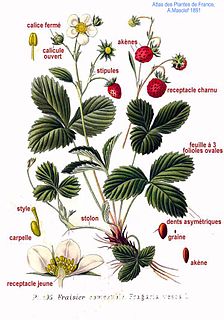
Fragaria is a genus of flowering plants in the rose family, Rosaceae, commonly known as strawberries for their edible fruits. There are more than 20 described species and many hybrids and cultivars. The most common strawberries grown commercially are cultivars of the garden strawberry, a hybrid known as Fragaria × ananassa. Strawberries have a taste that varies by cultivar, and ranges from quite sweet to rather tart. Strawberries are an important commercial fruit crop, widely grown in all temperate regions of the world.

A birch is a thin-leaved deciduous hardwood tree of the genus Betula, in the family Betulaceae, which also includes alders, hazels, and hornbeams. It is closely related to the beech-oak family Fagaceae. The genus Betula contains 30 to 60 known taxa of which 11 are on the IUCN 2011 Red List of Threatened Species. They are a typically rather short-lived pioneer species widespread in the Northern Hemisphere, particularly in northern areas of temperate climates and in boreal climates.
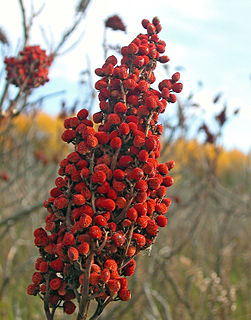
Sumac, also spelled sumach, is any one of about 35 species of flowering plants in the genus Rhus and related genera in the family Anacardiaceae. It grows in subtropical and temperate regions throughout the world, especially in East Asia, Africa, and North America.

The mandarin duck is a perching duck species native to the East Palearctic. It is medium-sized, at 41–49 cm (16–19 in) long with a 65–75 cm (26–30 in) wingspan. It is closely related to the North American wood duck, the only other member of the genus Aix. Aix is an Ancient Greek word which was used by Aristotle to refer to an unknown diving bird, and galericulata is the Latin for a wig, derived from galerum, a cap or bonnet.

Potentilla is a genus containing over 300 species of annual, biennial and perennial herbaceous flowering plants in the rose family, Rosaceae. They are usually called cinquefoils in English, but they have also been called five fingers and silverweeds. Potentilla are generally only found throughout the northern continents of the world (holarctic), though some may even be found in montane biomes of the New Guinea Highlands. Several other cinquefoils formerly included here are now separated in distinct genera - notably the popular garden shrub P. fruticosa, now Dasiphora fruticosa.

The western capercaillie, also known as the Eurasian capercaillie, wood grouse, heather cock, or simply capercaillie, is a heavy member of the grouse family and the largest of all extant grouse species. The heaviest-known specimen, recorded in captivity, had a weight of 7.2 kilograms. Found across Europe and the Palearctic, this primarily-ground-dwelling forest grouse is renowned for its courtship display. This bird shows extreme sexual dimorphism, with males nearly twice the size of females. The global population is listed as "least concern" under the IUCN, although the populations of Central Europe are declining and fragmented, or possibly extirpated.

The horned lark, called the shore lark in Europe, is a species of lark in the family Alaudidae found across the northern hemisphere.

Ground spiders comprise Gnaphosidae, the seventh largest spider family with nearly 2,000 described species in over 100 genera distributed worldwide. There are 105 species known to central Europe, and common genera include Gnaphosa, Drassodes, Micaria, Cesonia, Zelotes and many others. They are closely related to Clubionidae. At present, no ground spiders are known to be seriously venomous to humans.

The family Talpidae includes the moles, shrew moles, desmans, and other intermediate forms of small insectivorous mammals of the order Eulipotyphla. Talpids are all digging animals to various degrees: moles are completely subterranean animals; shrew moles and shrew-like moles somewhat less so; and desmans, while basically aquatic, excavate dry sleeping chambers; whilst the quite unique star-nosed mole is equally adept in the water and underground. Talpids are found across the Northern Hemisphere and southern Asia, Europe, and North America, although none are found in Ireland nor in the Americas south of northern Mexico.

Prunella is a genus of herbaceous plants in the family Lamiaceae, also known as self-heals, heal-all, or allheal for their use in herbal medicine.
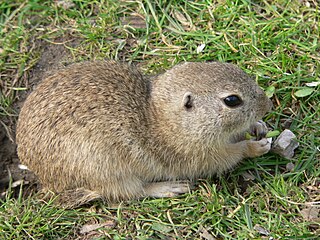
Spermophilus is a genus of ground squirrels in the squirrel family. As traditionally defined the genus was very species-rich, ranging through Europe, Asia and North America, but this arrangement was found to be paraphyletic to the certainly distinct prairie dogs, marmots, and antelope squirrels. As a consequence, all the former Spermophilus species of North America have been moved to other genera, leaving the European and Asian species as true Spermophilus.

The square-spot rustic is a moth of the family Noctuidae. It is found in Europe, North Africa and east across the Palearctic and in North America.

The steppe polecat, also known as the white or masked polecat, is a species of mustelid native to Central and Eastern Europe and Central Asia. It is listed as Least Concern by the IUCN because of its wide distribution, occurrence in a number of protected areas, and tolerance to some degree of habitat modification. It is generally of a very light yellowish colour, with dark limbs and a dark mask across the face. Compared to its relative, the European polecat, the steppe polecat is larger in size and has a more powerfully built skull.
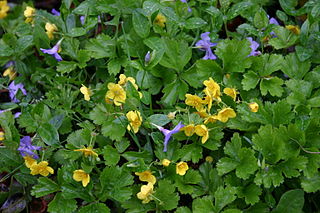
Waldsteinia fragarioides (syn. Dalibarda fragarioides Michx. and Geum fragarioides, also called Appalachian barren strawberry, or just barren strawberry, is a low, spreading plant with showy yellow flowers that appear in early spring. This plant is often used as an underplanting in perennial gardens.
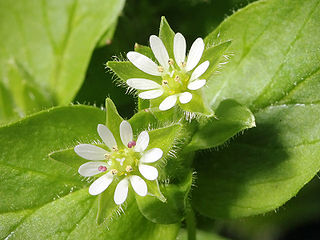
Stellaria media, chickweed, is an annual and perennial flowering plant in the family Caryophyllaceae. It is native to Eurasia and naturalized throughout the world. This species is used as a cooling herbal remedy, and grown as a vegetable crop and ground cover for both human and poultry consumption. It is sometimes called common chickweed to distinguish it from other plants called chickweed. Other common names include chickenwort, craches, maruns, and winterweed. The plant germinates in autumn or late winter, then forms large mats of foliage.
The Daurian ground squirrel is a species of rodent in the family Sciuridae. It is found in China, Mongolia, and Russia.

The tolai hare is a species of hare native to Central Asia, Mongolia, and Northern and Central China. It inhabits semi-desert, steppes, rocky habitats, and forest meadows. It is relatively common, even in areas with heavy human disturbance, due to its fast reproductive rate. It is mainly active at dusk and at night but is occasionally active during the day.
Barren strawberry is a common name for several plants which may refer to:


















